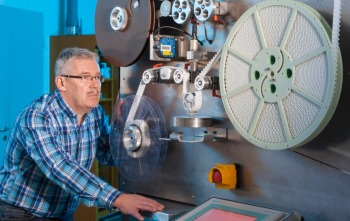Superconducting material limits short-circuit currents

Superconductors show zero resistance below the critical temperature and below the critical current. They are thus more energy efficient than conventional series reactors.
Despite the fact that superconducting components require cooling, the technology can help to reduce the power losses by half compared to the losses caused by currently usedseries reactors. Siemens will test the new superconducting fault current limiter in cooperation with the Augsburg municipal utility company and install a prototype in the grid by the end of 2015.
With the increase of renewable energy production, more and more biogas and solar facilities and wind farms are feeding energy directly into the medium-voltage power grid. Short circuits could thus cause high currents and require the installation of protective components. Series reactors alone, which damp short-circuit currents like a resistor, would not offer a solution.
They not only act as resistors when there is a short circuit, but also during normal operation. This causes electricity to be continuously wasted. The power loss typically amounts to 25 kilowatts per series reactor coil. Experts estimate that up to 44,000 series reactors are installed worldwide. That translates into a global power loss of up to 1,100 megawatts, which is the equivalent of a large power plant's output.
No resistance at minus 196 degrees
Superconductors solve that issue, because they can transport electricity with no resistance and almost no loss at low temperatures and below the critical current. They are in some sense “invisible” in the grid. The scientists at Siemens Corporate Technology have been researching high-temperature superconductors for more than 20 years now and have several key patents for resistive superconducting fault current limiters.
The scientists are using ceramic high-temperature superconductors made of yttrium-barium copper oxide, which are cooled down to minus 196 degrees Celsius with liquid nitrogen. If a short circuit occurs, the current increases strongly, and when reaching the critical current value of the superconductor, it will cause the superconductor to lose its superconducting properties and suddenly turn into a resistor.
The superconducting current limiter prototype will be combined with a series reactor, through which the short-circuit current will then be rerouted. That way the superconductor can cool off so that it will automatically be usable again a short time later.
In Augsburg, the current limiter will be installed between the grid of the Augsburg municipal utility company and a facility operated by MTU onsite energy. MTU manufactures cogeneration plants. While testing these, MTU feeds the produced electricity into the Augsburg grid.
The tests sometimes achieve peak outputs of 15 megawatts. Siemens plans to monitor the new technology for about one year, but both partners aim for a permanent installation even after the formal duration of the project. The cooperation project receives support from the Bavarian Ministry of Economics.
Press Picture: http://www.siemens.com/press/en/presspicture/?press=/en/presspicture/innovationn…
Media Contact
All latest news from the category: Power and Electrical Engineering
This topic covers issues related to energy generation, conversion, transportation and consumption and how the industry is addressing the challenge of energy efficiency in general.
innovations-report provides in-depth and informative reports and articles on subjects ranging from wind energy, fuel cell technology, solar energy, geothermal energy, petroleum, gas, nuclear engineering, alternative energy and energy efficiency to fusion, hydrogen and superconductor technologies.
Newest articles

A universal framework for spatial biology
SpatialData is a freely accessible tool to unify and integrate data from different omics technologies accounting for spatial information, which can provide holistic insights into health and disease. Biological processes…

How complex biological processes arise
A $20 million grant from the U.S. National Science Foundation (NSF) will support the establishment and operation of the National Synthesis Center for Emergence in the Molecular and Cellular Sciences (NCEMS) at…

Airborne single-photon lidar system achieves high-resolution 3D imaging
Compact, low-power system opens doors for photon-efficient drone and satellite-based environmental monitoring and mapping. Researchers have developed a compact and lightweight single-photon airborne lidar system that can acquire high-resolution 3D…





















